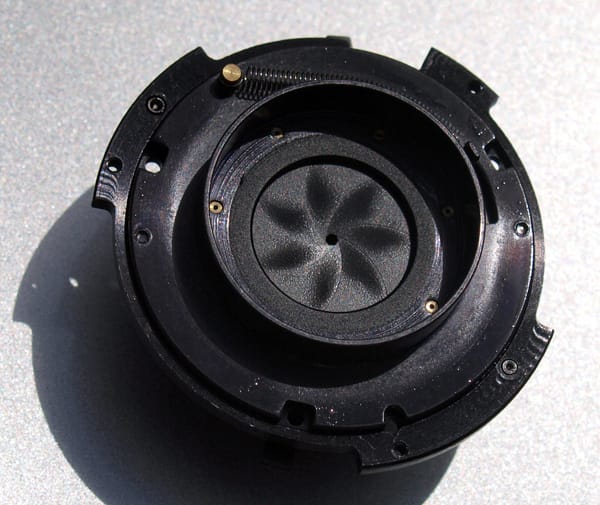The aperture blades are a very important component in a lens. When the blades are oily, it can cause many problems such as exposure issues. The oil causes the rate in which the blades open and close to be affected, which may over or under expose your image. If there is excess oil on the blades, they may not work correctly. Therefore, the blades should always remain dry in order to open and close properly.
Oily aperture blades are most commonly caused by age and heat exposure. Due to lubricants in the focus helicoids of your lens, there are times when that lubricant can leak.
An additional issue is oil getting on the lens elements. With continued use, excessive oil may splatter from the aperture blades on to the interior glass elements. If this is the case, you may now have soft focus spots, lower contrast and additional exposure issues.
How do you know if your lens has a problem? There are several steps you may follow to detect potential issues with a manual focus lens. First, take the lens off the camera and stop the lens down (closing the aperture). Using the aperture lever to open and close the blades, see if the blades snap back. If the blades close slowly instead of instantly snapping back, there is a definite issue which may be caused by oily aperture blades. You can also visually inspect the aperture blades (make sure you look at both sides). If you notice areas on the blades that are more shiny and darker than the other areas, or a liquid-like substance that looks pooled, this is a sign of excessive oil (see images above).
Some auto-focus lenses will be harder to inspect than manual focus ones. When these lenses are removed from the camera body, the aperture will remain in the open position. You may be able to inspect the blades from the front while the lens is on the camera. Some of the newer digital lenses may even give you a lens error code on your digital camera body if there is an issue.
The exception to the rule here is older, pre-set lenses. Since you manually stop down the aperture, oil on these blades does not affect the exposure. Common examples of the lenses that it does not affect are Leica M and Leica Screwmount lenses. If there is oil present on these aperture blades, it is okay and no cause for concern. It won’t affect function, but will factor into the overall lens condition or grade.
The only way to fix this problem is to remove the oil. The blades will need to be removed, inspected, cleaned and reassembled to make sure they are working properly. We do not advise anyone to take their lens apart to try and make the repair themselves. If you have a lens with oily aperture blades, you can contact the KEH Repair Center for a free repair estimate. We’ll be happy to assist you with all your repair needs.
